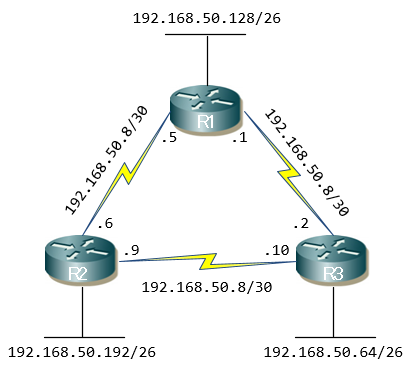

In the network diagram above, which path will packets take when travelling from host 192.168.50.126 to host 192.168.50.5?
上記のネットワーク図で、192.168.50.126のホストから192.168.50.5のホストへ行く時、パケットはどのパスを通るでしょうか
A. Packets will travel from R3 to R2 to R1.
R3 -> R2 -> R1を通る
B. Packets will travel from R1 to R3 to R2.
R1 -> R3 -> R2を通る
C. Packets will travel from R3 to R1 and return back to R3.
R3 -> R1 -> R3を通る
D, Packets will travel from R3 to R1 and from R3 to R2 to R1.
R3 -> R1 と R3 -> R2 -> R1を通る
E. Packets will travel from R1 to R2 and back.
R1 -> R2を通って戻る
CORRECT ANSWER - D
MORE INFORMATION:
We begin by identifying to which network host 192.168.50.126 belongs.
192.168.50.126がどのネットワークに属しているかを識別するところから始めます
*begin by ~で始める
IP address 192.168.50.126 is the last usable address for network 192.168.50.64/26, which means it is directly connected to router 3.
192.168.50.126のIPアドレスは192.168.50.64/26のネットワークで使用できる最後のアドレスで、それはルータ3に
直接接続されていることを意味しています。
Next, we need to identify where 192.168.50.5 is located.
次に、192.168.50.5がどこにあるのかを識別する必要があります。
By examining the diagram, we can see IP 192.168.50.5 is router 1's interface that connects directly with router 2.
ネットワーク図を調べると、192.168.50.5のIPアドレスはルータ2に直接接続されるルータ1のインタフェースにあることがわかります。
Finally, to understand the path packets will take, we examine the output of router 3's routing table and discover that there are two equal cost links to network 192.168.50.4/30, therefore EIGRP will load-balance between both paths.
最後に、パケットが通るパスを理解するために、ルータ3のルーティングテーブルの出力を調べると、ネットワーク 192.168.50.4/30に対する2つの等コストリンクがあることに気づきます。
従って、EIGRPは両方のパスで負荷分散をします。
